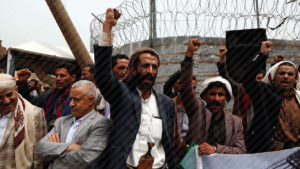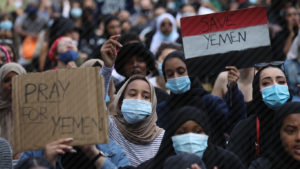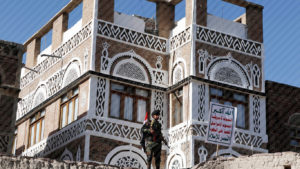How Has The Coronavirus Crisis Affected Yemen’s War?
Abstract: COVID-19 has spread rapidly in Yemen, although this has gone largely under-reported. The health system in the country has collapsed due to five years of war. After the declaration of a pandemic in March 2020, there were hopes that the domestic and external actors in the war would come to an agreement to contain the novel virus. Initially there were signs of greater communication between rival factions, and a Saudi Arabia-brokered ceasefire took effect in late March.
However, the steps taken soon faltered as each of the warring parties prioritized its own objectives over combating the virus. Saudi Arabia resumed its bombing of Houthi-held territory, while the Southern Transitional Council (STC), backed by the United Arab Emirates (UAE), exploited the situation created by the pandemic to achieve its goal of declaring an independent state in southern Yemen.
Meanwhile, the Iran-aligned Houthis ramped up their efforts to consolidate control over northern Yemen. International powers continue to fail to push for an end to the war, and their military support is enabling both Saudi Arabia and the UAE to pursue their diverging aims. As a result, 2020 has only triggered further instability.
On April 22, Yemen diagnosed its first case of COVID-19. This immediately raised fears that the novel coronavirus was spreading in the country undetected. The World Health Organisation and other bodies had already warned that the virus could diffuse rapidly, given the collapse of the health system during five years of war.
The war has witnessed the deliberate targeting of healthcare facilities, mostly by the Saudi Arabia-led coalition but also during Houthi attacks. In addition, the Saudi Arabia-led blockade of the country has combined with ongoing fighting to prevent aid and equipment from reaching hospitals. Soaring prices and the crumbling economy have made matters worse.
In March 2015, Saudi Arabia formed a coalition with the United Arab Emirates (UAE) to fight the Houthi rebels, who had launched an insurgency against the post-Arab Spring government of Abdrabbuh Mansur Hadi, which Saudi Arabia supports. The coalition was weakly backed by several other Arab and African states. Peace efforts, including the efforts of the United Nations, have failed.
The Houthis have consolidated their control over much of northern Yemen, and have even started firing missiles into Saudi territory. Forces backed by Saudi Arabia are still trying in vain to regain control of the Houthi-held territory.
Meanwhile, Riyadh’s close partner Abu Dhabi has supported the separatist Southern Transitional Council (STC), which launched a coup in Aden in August 2019 and then tried to conquer all the south of Yemen. It claims to want to revive the independent southern state which existed until 1990, when Yemen was divided between North and South.
Saudi Arabia and the UAE managed to reconcile their diverging policies under the Riyadh Agreement of November 2019, which foresaw that the two factions which they support should govern jointly in a power-sharing arrangement. However, tensions have erupted between the two, and the arrangement has broken down.
This briefing will show how the various domestic and external actors have prioritized their war aims in spite of the threat from COVID-19 and some initial positive signals of a possible reduction in violence and tensions to enable the country to combat the virus. It will also underline how a lax international peace effort has enabled the conflict to continue.
The Rapid Spread of COVID-19 in Yemen 
Aid organisations stress that Yemen’s health system has collapsed, and that only around half of Yemen’s healthcare facilities are fully functioning. The collapse of the health system has allowed many diseases and ailments to spread across the country, including a cholera epidemic with over one million cases.
On June 11th, Yemen’s Minister of Public Health and Population Dr. Nasser Ba’oum warned that Yemen’s population is at risk of contracting six diseases.
“About 30 million Yemenis are at risk of contracting COVID-19, malaria, dengue fever, chikungunya, cholera and typhoid,” he said at a meeting with Arab ministers of health.
According to statistics, the number of coronavirus cases in Yemen is low but the death rate works out at about 25 per cent – much higher than the global average. In fact, aid organisations like Médecins Sans Frontières (Doctors Without Borders) have noted that the lack of health equipment has made it impossible to counteract the spread of the virus.
Although the official infection rate is low, local reports indicate that the virus has spread rapidly, resulting in an unprecedented number of unrecorded deaths. The southern port city of Aden, the temporary capital of the Hadi government, evidently became a hotspot early on. Since May, aid organisations and individuals on the ground have repeatedly reported that the virus is flourishing there.
In May, gravediggers reported that the number of deaths had been many times higher than normal, and that they were conducting several dozen extra burials every day.
The Yemeni government declared Aden “infested” because of the rapid contagion rates.
Cases of the virus have also been observed in many other parts of the country, including all the major centres of population, among them Hadramout, Sanaa, Saada, Marib, Abyan, Mahrah and Shabwah. On June 16th, the Ministry of Health stated that a large proportion of the recorded cases have come from Hadramout, suggesting that this governorate has become another hotspot.
Residents of the capital Sanaa report that they have experienced dozens of people around them dying suddenly, including family members and relatives. The Houthis, who control Sanaa, have backed some partial closures. Nevertheless, they have continued to cover up the extent of the health crisis. In these circumstances, it is difficult for citizens to be aware of the spread of the virus. This in itself could accelerate the epidemic.
There has been much speculation about why the Houthis have not been clear about the number of cases. While reputational issues may be partly responsible, the most plausible explanation is that public knowledge of how much the virus has spread would hinder the faction’s recruitment and mobilization efforts. The Houthis have commandeered aid deliveries and sold them on, seeking to profit and empower themselves within their own territories amid the humanitarian crisis.
Evidently, they are prioritizing their own operations and power. Various models point to a huge incidence of COVID-19 across Yemen. Infections may already have reached one million, according to research by the London School of Hygiene and Tropical Medicine, which projects a worst-case scenario of up to 85,000 deaths.
While it is difficult to track the spread of the virus completely, it is clear that it has become a widespread problem within the country. Another scenario anticipates that by the time the pandemic is over, 55 per cent of Yemen’s population, or 16 million people, could become infected.
Meanwhile, coronavirus-related factors including declining remittances and lockdowns have damaged Yemen’s crippled economy further.
These factors have already increased the potential for the warring factions to recruit impoverished civilians. As a long-term result, the virus could therefore destabilize Yemen further and add to its problems, particularly while the violence goes unresolved.
The Actions of the Parties to the Conflict 
On March 25th, UN Secretary General Antonio Guterres called for a region-wide ceasefire encompassing various conflicts. Along with UN Envoy to Yemen Martin Griffiths, Guterres called on the domestic warring parties in Yemen – namely, the Houthis, the Hadi government and the STC – to halt their operations and work towards a political solution, amid fears of the virus spreading.
Below the surface however, there were ongoing tensions between the Hadi government and the STC, and signs that the Riyadh Agreement was collapsing.
Yemeni authorities, including the Houthis and the Hadi government, cooperated to contain the virus, notably through joint efforts to enforce the closure of schools and the prohibition of flights.
In April, the STC reported that it had held a meeting with the governor of Aden, Ahmed Salmin, to discuss ways of combating the epidemic. This included reviewing the public health preparations and the state of supplies in case of an outbreak.
Later the same month, however, southern activists called for the dismissal of Salmin, who is aligned with Hadi, suggesting tensions between the separatists and government.
Since then, there have been various clashes between forces loyal to Hadi and the STC, particularly in the oil-rich eastern governorate of Shabwah. Shabwah has been a microcosm of tensions between the two sides. The STC remains opposed to the influence of the al-Islah party, which is aligned with the government. Both sides are seeking influence over the province’s natural resources.
On April 25th, after the Riyadh Agreement had repeatedly stalled, the STC spotted an opportunity to ‘declare’ self-rule from the city of Aden. The Hadi government wanted to reassert its control over southern Yemen and reunite the coalition forces against the Houthis, but the STC still desired independence from the government and power over the south.
Realising that it would not get its way, it pushed forward and sought to establish control. The violence later continued in Abyan, another governorate contested by the Hadi government and the STC. On June 12th, for example, the STC killed two servicemen in an ambush on security personnel.
A key centre of tensions was the geostrategic island of Socotra, approximately 250km off Yemen’s coast. STC forces have sought to wrest the island from the government ever since the UAE supported their takeover in May 2018.
They finally managed to secure control of the island on June 20th. In subsequent days, clashes continued both in Abyan and in Mukalla, in Hadramawt, notwithstanding efforts by Saudi Arabia to establish a ceasefire. Clearly, the STC remain determined to press their bid for southern independence whereas the Hadi government is focused on reuniting the anti-Houthi coalition and securing its own control elsewhere in the country.
The Houthis, for their part, are trying to consolidate their control over various parts of northern Yemen. Currently, they are facing a tribal insurrection in the governorate of Al Bayda, which is strategically located in central Yemen. However, the Houthis are militarily stronger than such local factions.
They are also advancing on Marib, which they have been making vigorous efforts to conquer since a Houthi-linked missile attack on a government military camp in January. Capturing this last bastion of Hadi forces in northern Yemen would consolidate the Houthis’ power in the region and boost their national standing.
Since launching their insurgency in September 2014, the Houthis have consistently sought to capture as much Yemeni territory as possible. The assassination of Iran’s Major General Qassem Soleimani by the United States in January sparked Houthi outrage, as did the Riyadh Agreement, which the Houthis opposed because it sought to reunify the coalition and marginalize them. These events have arguably spurred the Houthis on, in addition to their desire to topple the Hadi government and fight Saudi Arabiabacked forces.
Evidently, the coronavirus crisis has brought very little, if any, lasting change in the way the Houthis, the STC and the government A key centre of tensions was the geostrategic island of Socotra, approximately 250km off Yemen’s coast. STC forces have sought to wrest the island from the government ever since the UAE supported their takeover in May 2018 7 forces operate vis-a-vis one another. An important factor here is the way in which the regional and international powers which support the various factions have been addressing the conflict.
The Roles of Regional Powers

Security measurements are taken as supporters of Houthis participate in march on the occasion of the fifth anniversary of Houthis’ control of the Yemeni capital Sanaa, on September 21, 2019.
After carrying out numerous air strikes on Houthi territory at the end of March, the Saudi Arabia-led coalition announced a two-week ceasefire, which went into effect on April 9th. Rather prematurely, various observers concluded that Saudi Arabia was seeking to scale down its role in Yemen, and some even speculated that the Kingdom might be looking to withdraw from the war completely.
At the time, Saudi Arabia was facing growing economic challenges due to the coronavirus crisis. Oil prices crashed to unprecedented lows in April, and international services declined due to lockdowns. In May, Saudi Arabia announced new taxes and austerity measures.
The ceasefire was extended by one month after its expiry , and Saudi Arabia’s operations declined by comparison with previous years. Nevertheless, Saudi Arabia was not about to wind down its war effort. In May, Riyadh secured a new missile contract worth nearly USD2 billion with the US arms company Boeing.
This deal made clear that military prowess remained a priority, and did not suggest that the pandemic had made Saudi Arabia more cautious and pragmatic. On June 15th, the Saudi Arabia-led coalition carried out air strikes on the northern governorate of Saada, killing 13 civilians including four children. The Saudi air strikes continued, and residents described them as the heaviest in years.
These assaults confirmed that speculation that the coronavirus crisis might push Saudi Arabia into withdrawal had been exaggerated.
One aspect of Saudi Arabia’s foreign policy which has changed amid the coronavirus crisis, however, has been the increased use of aid as a form of soft power. Through the Saudi Development and Reconstruction Program for Yemen (SDRPY), Riyadh has made donations across the country, encompassing all sectors. This strategy aims to enable Saudi Arabia to establish more links in Yemen and increase its direct influence.
In addition, Saudi Arabia has recently been pushing for a revival of the Riyadh Agreement, showing that it is still keen to secure Hadi’s control over the country and achieve its increasingly distant goal of reunifying the Saudi Arabia-led coalition against the Houthis. All in all, Saudi Arabia is looking for ways of reinforcing its influence, which has been jeopardized by the tangible gains which the STC and the Houthis have been making in southern and northern Yemen, respectively.
Saudi Arabia’s acceptance of the STC victory shows that the UAE has been gaining the upper hand and has gradually consolidated its presence in the south. The UAE has pushed ahead with its bid to consolidate its geopolitical ambitions to control southern Yemen and its ports, regardless of the coronavirus crisis.
Iran made no official response – let alone a positive one – to the ceasefire in April. Since the beginning of the war, Iran has gradually moved closer to the Houthis. In the second half of 2019, in particular, the two became more open about their ties, and further evidence emerged of Tehran’s support for the faction.
Iran would likely prefer the Houthis to gain full control over northern Yemen, as this would help it consolidate its own influence. It has made little effort to extend its influence through political means.
Although Iran has supported the Houthis’ war efforts, it has less leverage over them than the UAE has over the STC or Saudi Arabia has over Hadi. Despite claims to the contrary, Iran can only play a minimal role in ending the war. It has delivered support to the Houthis in the past and its role has not changed significantly since the coronavirus was declared a pandemic. It would still prefer to maximize the Houthis’ political sway as much as possible.
Response From the International Community
The international community has raised awareness about the situation in Yemen and has called on the country’s leaders to push for greater transparency and a ceasefire. However, there has been little pressure on Saudi Arabia and the UAE to end their roles in the conflict and to establish a viable political solution.
If anything, the global fixation on countering the coronavirus pandemic may have further distracted attention from efforts to resolve the conflict in Yemen. The international powers that support the Saudi Arabia-led coalition have neither addressed its role in the conflict nor pressured it into seeking a peaceful solution.
The United Kingdom, one of Saudi Arabia’s main suppliers of weapons, has shown public concern about the Yemen conflict and reiterated the need for a political solution. UK Foreign Office Minister James Cleverley said that Yemen’s warring parties should seek compromise and address their differences in order to contain the spread of the virus.
What this statement shows above all, however, is that the UK has still failed to rein in Saudi Arabia and persuade it to seek a real solution to the conflict, even though it is the UN Security Council pen holder for Yemen, which means that it is Britain’s responsibility to draft resolutions on the conflict.
The policies of the United States have resulted in a reduced flow of aid to the conflictaffected areas. In April, the World Food Program cut aid to Yemen following reports of the Houthis obstructing deliveries. The US decision to cut funding to the World Health Organisation (WHO) has also made it difficult for the organisation to maintain aid operations effectively – although President Donald Trump’s administration did reinstate some aid in response to pressure.
In essence, the US under Trump is taking a more isolationist stance globally, and Yemen is no exception. However, both the United Kingdom and the United States are still selling billions of dollars’ worth of weapons to Saudi Arabia, thus implicitly giving their consent to the operations of the Saudi Arabia-led coalition. There has been no scaling-back of the arms trade during the coronavirus crisis. Ultimately, Saudi Arabia has the freedom and impunity to continue its intervention.
Concerns about aid shortages persist. At the fundraising event hosted by Saudi Arabia and the UN on June 2nd, the top priority was to ensure the delivery of aid to alleviate Yemen’s humanitarian crisis. The funding fell short: only about half of the USD2.4 billion required to meet Yemen’s humanitarian needs was raised.
Much of the discourse about Yemen has revolved around the need for aid. While aid is important to alleviate short-term humanitarian problems, aid alone cannot defuse Yemen’s long-running crisis and stabilize the country.
Conversely, the lack of a political solution means that it will be harder to guarantee aid flows. Furthermore, Although Iran has supported the Houthis’ war efforts, it has less leverage over them than the UAE has over the STC or Saudi Arabia has over Hadi Saudi Arabia has only partially eased the blockade it imposed on Yemen in November 2017 – a clear instance of how the ongoing conflict is preventing aid from reaching the country.
The UN peace efforts have stalled repeatedly, largely due to its inability to put pressure on the warring sides. Although the coronavirus did prompt extra negotiations, particularly in April, when UN Envoy Martin Griffiths called for more focused peace talks [24], this did not lead to any significant improvement on the ground.
Notwithstanding the COVID-19 pandemic, the violence in the country will continue in the absence of greater efforts from the international community to put an end to the conflict. Even if the war were to be ended, moreover, the socio-economic damage from the coronavirus could lead to renewed instability unless lasting efforts are made to bolster Yemen’s infrastructure.
How Has The Coronavirus Crisis Affected Yemen’s War?
COVID-19 has spread rapidly in Yemen, although this has gone largely under-reported. The health system in the country has collapsed due to five years of war. After the declaration of a pandemic in March 2020, there were hopes that the domestic and external actors in the war would come to an agreement to contain the novel virus. Initially there were signs of greater communication between rival factions, and a Saudi Arabia-brokered ceasefire took effect in late March.

 Jonathan Fenton-Harvey
Jonathan Fenton-Harvey